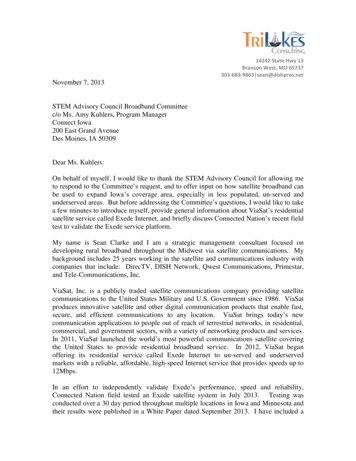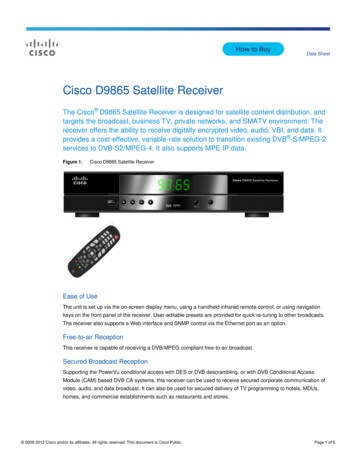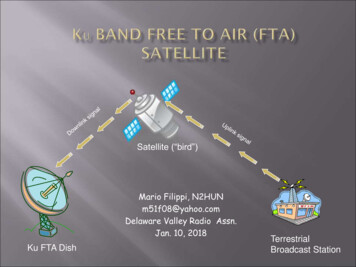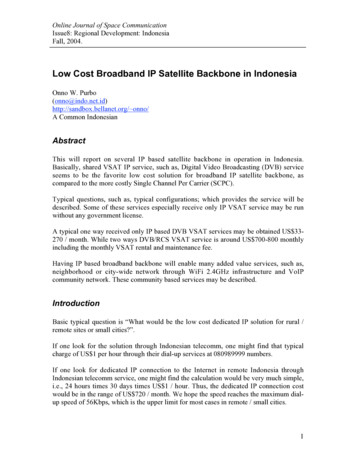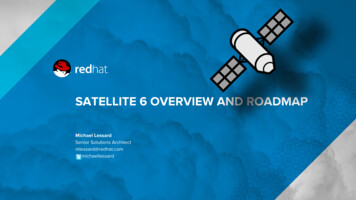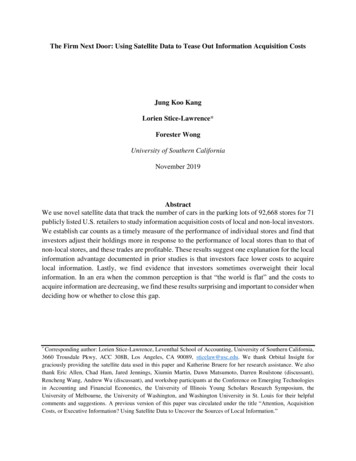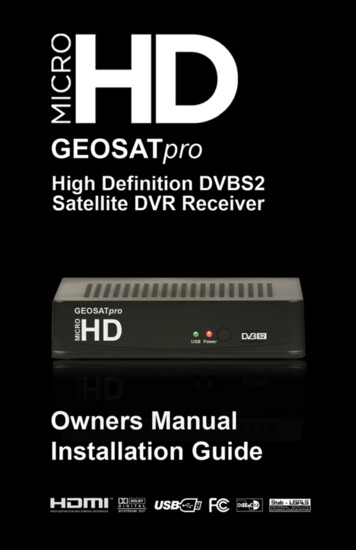
Transcription
Basics of Satellite Communications(Duration: 90 Minutes)Note: Please ask Questions Anytime!Presenter:E. Kasule MusisiITSO ConsultantEmail: kasule@datafundi.co.ugCell: 256 772 783 784Skype: ekasule
Topics in this Module Birth of Satellite Communications Communication Links The Space Segment Satellite Design The Ground Segment Satellite Orbits Earth Station Registration Orbital Positions and Radio Interference Services Satellite Lifecycle Management Technology Trends Polarisation Introduction to Satellite Link Analysis
Birth of satellite communications1/11Communications satellites may be used for many applications: relaying telephone calls providing communications to remote areas of the Earth, TV direct-to-user broadcasting providing communications to ships, aircraft and other mobile vehicles etc .
Birth of satellite imeCommunicationsOil & icesDTHCableDistributionMCPCPlatformsSpecial EventsSatelliteNewsGatheringMobile SituationalAwareness
Birth of satellite communicationsA communications satellite acts as a repeater3/11
Birth of satellite communications4/11Frequently Asked Questions (FAQs) Who invented satellites? Arthur C. Clarke, who went on to be a well-read author of science fiction novels. When were satellites invented? The first satellites were experimented with in the late 1950’s and early 1960’s. Intelsat’sfirst satellite, which was called ‘Early Bird’, was launched on 6 April 1965. How big is a satellite? (Based on the Intelsat 9 series) Before liftoff it’s, about 4,500 kilograms! Without fuel, it’sabout 2,000 kilograms! The body is 5.6 meters and the solar panels are 31 meters wide– more than a 10-story building! How many years can a satellite last? It varies by satellite type. The type of satellites owned by Intelsat can last over 20 years,but typically their work life is approximately 15 years.
Birth of satellite communicationsFrequently Asked Questions : 5/11How do you fix satellites if they get broken? The satellites send back ‘health check’ information to ground engineers all the time. Predeveloped commands are sent to the satellite to perform certain functions, such as firing abooster or changing the angle of a solar panel, so that it can repair itself. How does a satellite get its power? Mostly solar power collected by the solar arrays/panels. There are also batteries on thesatellites for the times when the satellite passes through the earths shadow. This is calledeclipse. How much power does it take to transmit a signal? The power used to send a communications signal to the Earth from a satellite is about thesame as a typical 60W light bulb, just like you have at home. What kinds of people work in the satellite industry? All kinds! Engineers, rocket scientists, sales people, writers, accountants and lawyers.
Birth of satellite communications6/11In the context of spaceflight, a satellite is an object which has been placedinto orbit by human endeavor.Such objects are sometimes called artificial satellites to distinguish themfrom natural satellites such as the Moon.
Birth of satellite communications7/11First satellite was launched in 1957 by Russia. It was named “Sputnik 1”
Birth of satellite communications8/11INTELSAT I (nicknamed Early Bird for the proverb "The early bird catchesthe worm") was the first (commercial) communications satellite to beplaced in geosynchronous orbit, on April 6, 1965.
Birth of satellite communications9/11Benefits of Satellites Adaptable to customer requirements Mobility Cost advantage Not affected by geographical obstructions Quick implementation Alternate routing or redundancy Cost is independent of distance Cost effective for short term requirements
Birth of satellite communications10/11Satellites are complementary to cable for the following reasons: Submarine cables (and landline fibre) are subject to cuts Interim solutions for cellular backhaul and internet trunking Satellite systems utilizing MEO (medium Earth orbit) have bothhigh capacity and high quality (low latency) and cost.
Birth of satellite communicationsTypes of satellites11/11 Communications satellites Weather satellites: provide meteorologists with scientific data to predictweather conditions and are equipped with advanced instruments Earth observation satellites Navigation satellites: Using GPS technology these satellites are able to providea person's exact location on Earth to within a few meters Broadcast satellites: broadcast television signals from one point to another(similar to communications satellites). Scientific satellites : perform a variety of scientific missions e.g. the TheHubble Space Telescope Military satellites
Communication Links1/4UplinkUplink - The transmission of signals to the satellite
Communication Links2/4Downlink sDownlink - The transmission of information from the satellite.Many Earth Stations can be covered by one satellite beamfootprint
Communication Links3/4 NOTE: Satellites receive at a different frequency thanthey transmit at Different wavelengths give different radiationpatterns on the antennae This causes slightly different footprints for uplinkand downlink For marketing reasons the patterns may bedifferent
Communication Links 4/4A satellite beam “footprint”
The Space Segment1/6A satellite communications (satcom) system maybelooked at as comprising of three parts “spacesegment”, the “ground segment” and the transmissionmedium ( the space between the Earth and thesatellite)
The Space Segment2/6 A telecommunications satellite comprises: A platform (or bus): propulsion system, fuel tanks,batteries, solar panels, attitude and orbit controlfunctions, etc. It is usually standardized by themanufacturer. A payload: the equipment used to provide the service forwhich the satellite has been launched. It is customized fora given mission .
The Space Segment3/6The Transponder:This is the equipment which provides the connectinglink between the satellite’s transmit and receiveantennas. It forms one of the main sections of thepayload, the other being the antenna subsystems.
The Space Segment4/6Block Diagram of a Communications SatellitePropulsion SystemTelemetry, Attitude Control,Commanding, Fuel, BatteriesPower System/Thermal SystemSolar rReceiver r ArraysTransponderTransmitter SectionFilterRx AntennasTx Antenna
The Space Segment5/6Satellite Capacity Typically satellites have between 24 and 72transponders. A single transponder is capable of handling up to 155million bits of information per second (155 Mbps)
The Space Segment6/6A closer look at the Transponder
Satellite Design1/1Key aspects of Satellite Design: Electrical Power Station Keeping Attitude Control Orbital Control Thermal Control
Satellite Design1/2Orbital Control Necessary keep the satellitestationary with respect to allthe earth station antennasthat are pointed at it. Each satellite carries a thrustsubsystem to give it anoccasional nudge to keep it"On Station."
Questions so far?
The Ground Segment1/15Topic Outline: Earth station components Factors governing antenna sizes The differences between a major earth station and a VSAT Permissions required to install and operate a VSAT / Earthstation
The Ground Segment2/15IndoorOutdoorEquipment RackFeed HornContains: Modems,RF Power AmplifiersData CommunicationsEquipmentData Networking EqptUPSetcIFLReflectorRigid MountingEarth Station Components – generic simplified diagram
The Ground Segment3/15Earth Station Components- simplified list Reflector – Physical reflecting piece – focuses signal into the LNB assembly and / orfocuses the transmission signal towards the satellite Feed horn – Device to accept the focussed RF signals into the LNB or conversely tooutput the RF signal to the satellite Power amplifier – Device that accepts a signal from the modem and boosts it to asuitable level for onward transmission to the satellite LNA,B or C – Low Noise Amplifier – Receives the signal from the satellite, Modem – Converts a data signal to one suitable for transmission to the satellite Up Converter– Converts the modulated signals from RF to RF frequency Down Converter– Converts the modulated signals from RF to RF frequency Mounting – Some form of mounting to hold the antenna assembly vertical andpointed correctly under most normal condition
The Ground Segment4/15Uplink Block DiagramAntennaModemIFLUp-ConverterSimplified Uplink Block DiagramIFLTransmitterIFLFeed
The Ground Segment5/15Downlink Block DiagramModemIFLDown-ConverterIFLSimplified Downlink Block DiagramLNAFeed
The Ground Segment6/15Picture of a VSATReflectorGroundMountwithweights
The Ground Segment7/15Picture of a VSAT componentsFeed horn assemblyRF Power amplifier(SSPA)LNBTransmit cableFrom indoor modemReceive cableFrom LNB modem
The Ground Segment 8/15Factors governing Reflector sizesWhy install a large antenna when a small one would do the job? Transmission: Large earth stations have smaller BEAM Width's therefore pointmore accurately Less RF signal wastage Less co-satellite interference Link budget requirement Cost factors Larger antenna may be less than the cost of a lease with asmaller antenna
The Ground Segment9/153D Antenna Radiation Pattern
The Ground Segment10/15 Receiving: Antenna Gain dictated by the Link Budget Large earth station can receive a weaker signal thanthe equivalent small antenna Cost implications with the Link Budget Planning permissione.g. Europe 0.9M is the minimum size
The Ground Segment11/15The differences between a Major Earth Station and a VSAT VSAT – Very Small Aperture Terminal A VSAT is typically a small earth station 0.7M to 3.7M Usually operates a single service or application Major Earth Station Typically A Major Earth station is sized from 3.7M to 16M weighing 20 T or more costing 1M Basically same components in each station Supports multiple services All components redundant Can transmit and receive in multiple polarisations Usually configured with large RF power amplifiers Always connected to suitable Power supplies Usually connected to multiple terrestrial paths
The Ground Segment12/15Photos of Large earth station antennas
The Ground Segment13/15Permissions required to install & operate a VSAT /Earth station Just because it can work does not necessarily mean you may goout install and operate! Planning permission Local Authority building departments Zoning issues Landlord’s permissionWill the landlord permit your activity? Regulatory authorityDoes the law allow you to build and operate?
The Ground Segment14/15Teleports: Multiple large earth stations Well specified antennas Good power systems Ample Rack space for ancillary equipment 24X7 staff on-site to maintain systems Quality support and technical staff to assist with design, installand operation Good terrestrial connectivity Preferably to more than a single fibre supplier
The Ground SegmentA Typical Teleport15/15
Questions so far?
Satellite Orbits1/7MEOLEOGEO
MEOSatellite OrbitsTypeDescriptionHeightSignal Visibility /orbitLEO2/7GEOLEOMEOGEOLow Earth OrbitEquatorial or polarorbitMedium Earth OrbitEquatorial or Polar orbitGeostationary Earth OrbitEquatorial orbit100-500 miles6000-12000 miles22,282 miles15 min2-4 hrs24 hrsAdvantagesLower launch costsShort round trip signaldelaySmall path lossModerate launch costSmall round trip delaysCovers as much as 42.2% ofthe earth's surface Ease oftrackingNo problems due to dopplerDisadvantagesTracking antennarequiredShort life, 5-8 yearsEncounters radiationbeltsTracking antenna requiredLarger delaysGreater path loss thanLEO'sLarge round trip delaysWeaker signals on Earth
Satellite Orbits3/7Applications Low Earth Orbit: Earth Observation International Space Station Satellite communications (constellations) Medium Earth Orbit: Navigation: GPS, Galileo, GLONASS, etc Satellite communications (constellations) Geostationary Earth Orbit: Satellite communications Meteorology
Satellite Orbits4/7
Satellite Orbits5/7Inclined Orbits: Implicationsfor earth station tracking:Stations must have trackingsystems so that their pointingis adjusted to aim at thesatellite all during the day.
Satellite Orbits6/7Orbital Slot RegistrationThe ITU Member States have established a legal regime, which is codified through theITU Constitution and Convention, including the Radio Regulations.In 1988, the ITU acknowledged that all countries, including lesser developedcountries, have an equal right to orbital slots. However, Article II of the Outer SpaceTreaty forbids any claim of sovereignty by any country in space, which would notallow countries to establish dominion over the orbital slots above their territory. Atconferences in 1985 and 1988, the ITU did give all countries the rights to an orbitalslot directly over their territory, which would ensure at least some access to thesesatellites to all countries.
Satellite Orbits7/7
Building and launching a telecommunicationssatellite 1/3 It takes about 3 years to get a GEO telecom satellite built andlaunched. Satellite payloads are customized for a given mission. Satellites are heavily tested on the ground in facilities thatreproduce the space environment: Mechanical, Thermal, Noise and RF tests Typical cost of a satellite is 150- 250 million Some satellites can cost as much as 500 million. Not including launch services ( 55- 100 million) and insurance.
Building and launching a telecommunicationssatellite 2/3GEO Satellite LaunchMultiple burns to achieve GEO orbit
Building and launching a telecommunicationssatellite 3/3Generic Transfer Orbit ProfileGeneric Transfer Profile
Earth Station and VSAT Registration1/5A licence is required by the national telecommunicationsauthority of a country where any earth station as a part of anetwork, be it the hub, a control station or a VSAT, is plannedto be installed and operated.
Earth Station and VSAT Registration2/5In the past, national telecommunication authorities haverequired licensing of individual VSAT terminals in addition torequiring a network operator’s license. Then, the US FederalCommunication Commission (FCC) implemented with success ablanket licensing approach for VSATs operated within the US.
Earth Station and VSAT Registration3/5In the past, national telecommunication authorities haverequired licensing of individual VSAT terminals in addition torequiring a network operator’s license. Then, the US FederalCommunication Commission (FCC) implemented with success ablanket licensing approach for VSATs operated within the US.
Earth Station and VSAT Registration4/5Blanket licensing has since gained interest among nationaltelecommunications authorities all over the world, as a result ofequipment manufacturers complying with the recommendationsissued by international standardization bodies, such as theInternational Telecommunication Union (ITU) and the EuropeanTelecommunications Standards Institute (ETSI).
Earth Station and VSAT Registration5/5A licence usually entails the payment of a licence fee, which ismost often in two parts: a one-time fee for the licensing workand an annual charge per station.The licensing procedure is simpler when the network is national,as only one telecom authority is involved.For transborder networks, licences must be obtained from thenational authorities of the different countries where therelevant earth stations are planned to be installed andoperated, and rules often differ from one country to another.
Orbital positions and radio interferencesControl of InterferenceALLOCATIONFrequency separation of stations ofdifferent servicesPOWER LIMITSPFD to protect TERR services / EIRP toprotect SPACE services / EPFD to protectGSO from Non-GSOREGULATORY PROTECTIONe.g. No. 22.2: Non-GSO to protect GSO(FSS and BSS)COORDINATIONbetween Administrations to ensureinterference-free operations conditions
Radio Regulatory Organisations 1/3National RegulationUltimately the responsibility for licensing falls to a National RegulatoryAuthority (a Government department), e.g.– Ofcom in the United Kingdom– FCC & NTIA in the USA
Radio regulatory organisations 2/3ITSOITSO is the continuation of INTELSAT, the intergovernmental organizationestablished by treaty in 1973.On July 18, 2001, the satellite fleet, customercontracts and other operational assets of the Organization were transferredto Intelsat Ltd, a new private company now registered in Luxembourg andvarious amendments to the ITSO Agreement took effect.Under the ITSO Agreement, as amended , ITSO’s primary role was thatof supervising and monitoring Intelsat’s provision of publictelecommunications satellite services as specified in the Public ServicesAgreement(PSA) entered into between ITSO and Intelsat. In addition, theDirector General , on behalf of the Organization, must consider all issuesrelated to the Common Heritage. ITSO currently has 149 Member States.”
Radio regulatory organisations 3/3ITSOThe International Telecommunications Satellite Organization is anintergovernmental organization charged with overseeing the public serviceobligations of Intelsat.GVFGlobal VSAT Forum is an association of key companies involved in thebusiness of delivering advanced digital fixed satellite systems and services.
Satellite OperatorsSatellite OperatorsIntelsat, Ltd. is a communications satellite services provider. Originallyformed as International Telecommunications Satellite Organization(INTELSAT), it was an intergovernmental consortium owning and managing aconstellation of communications satellites providing international broadcastservices. As of March 2011, Intelsat owned and operated a fleet of 52communications satellites.Eutelsat S.A. is a French-based satellite provider. Providing coverage overthe entire European continent, as well as the Middle East, Africa, India andsignificant parts of Asia and the Americas, it is one of the world's threeleading satellite operators in terms of revenues.
Satellite OperatorsO3b is building a next-generation network that combines the reach ofsatellite with the speed of fiber.Higher capacityO3b’s satellite transponders have on average three to four times the capacityof those offered by GEO satellite systems. This translates into three to fourtimes more bandwidth – and a fiber-like experience for customers.Greater coverageSatellite technology can deliver Internet connectivity to any location on theplanet. O3b’s next-generation satellite network will reach consumers,businesses and other organisations in more than 150 countries across Asia,Africa, Latin America and the Middle East.
Satellite OperatorsLower latencyO3b’s unique network of Medium Earth Orbit (MEO) satellites virtuallyeliminates the delay caused by standard Geosynchronous (GEO) satellites.Round-trip data transmission time is reduced from well over 500 millisecondsto approximately 100 milliseconds.This creates a web experience significantly closer to terrestrial systems suchas DSL or Optical Fiber.
Satellite OperatorsInternational OrganizationThe International Mobile Satellite Organization (IMSO) is the intergovernmentalorganization that oversees certain public satellite safety and securitycommunication services provided via the Inmarsat satellites. These public servicesinclude:services for maritime safety within the Global Maritime Distress and Safety System(GMDSS) established by the International Maritime Organization (IMO) distress alerting search and rescue co-ordinating communications maritime safety information (MSI) broadcasts general communications
Satelite ServicesThe Commercial Satellite IndustryVoice/Video/Data Communications Rural Telephony News Gathering/Distribution Internet Trunking Corporate VSAT Networks Tele-Medicine Distance-Learning Mobile Telephony VideoconferencingGPS/Navigation Position Location Timing Search and Rescue Mapping Fleet Management Security & Database Access Emergency Services Business TelevisionRemote Sensing Broadcast and Cable Relay Pipeline Monitoring VOIP & Multi-media over IP Infrastructure Planning Forest Fire PreventionDirect-To-Consumer Broadband IP DTH/DBS Television Digital Audio Radio Interactive Entertainment & Games Video & Data to handhelds Urban Planning Flood and Storm watches Air Pollution Management Geo-spatial Services
Technology trendsMarket trends for capacity – continues to grow despite fibre deployment Potential shortage of capacity in some areas for certain types ofcapacity due to heavy cutbacks in launches Bandwidth is ever increasing on a per link basis
Technology trendsUser demands Smaller terminals High throughput Enhanced capability Constellations Responsive space Lower costs - 1000 now and lower! Easier access to space segment Easier licensing regimes Open standards
Technology trendsOpen Standards? Industry Players (Satellite Operators, Network Operators,Equipment manufacturers and End-users) agree that OpenStandards are good for everyone But which one is the best one or is it a multitude of answersand solutions?
8- Technology trends Global usage and coordination Ka / Ku/ C Band Interference issues Global Regional frequency coordination
Questions so far?
Polarization1/5 Linear Polarization Circular Polarization Polarization Frequency Re-use
Polarization2/5 Electromagnetic waves have an electrical field and a magneticfield which are orthogonal to each other and to the direction ofpropagation Polarization of a signal is defined by the direction of the electricalfield. Polarization can be: Linear: Horizontal (H) or Vertical (V) Circular: Right Hand Circular (RHCP)or Left Hand Circular (RHLP)
Polarization3/5 The electrical field is whollyin one plane containing thedirection of propagation Horizontal: the field lies in a planeparallel to the earth’s surface Vertical: the field lies in a planeperpendicular to the earth’s surface
Polarization4/5Circular Polarization The electrical field radiates energyin both the horizontal and verticalplanes and all planes in between Right-Hand Circular Polarization:The electrical field is rotating clockwiseas seen by an observer towards whomthe wave is moving Left-Hand Circular Polarization:The electrical field is rotating counterclockwiseas seen by an observer towards whom the wave is moving
Polarization5/5Polarization frequency re-use A satellite can get twice the capacity on the same frequency channels byusing opposite polarizations over the same coverage area. E.g. Transponder A using 6,000-6,072 MHz in vertical polarizationTransponder B using 6,000-6,072 MHz in horizontal polarization In case of misalignment of polarization between transmitter and receiver,there is cross-pol interference. Cross-pol discrimination (XPD) is defined as the ratio of power transmittedon the correct polarization to the power transmitted on the incorrectpolarization. The specified XPD is usually in the range of 20-30 dB forVSATs.
Questions so far?
Introduction to Satellite Link Analysis1/9Components of a satellite circuitSatelliteAntennaBUCLNBModemThe antennatransmits/receives andfocuses the energy of thesignal towards/from thesatellite.The LNB amplifies thereceived signal andconverts down itsfrequency for reception bythe modemThe satellite receives thesignals, filters them,converts the frequenciesthen amplifies them fortransmission down to theEarthAntennaThe BUC amplifies andconverts up the signal fortransmission by theantennaThe modem modulatesand demodulates thesignal and is connected toother user equipment(router, TV, etc)BUCLNBModem
Introduction to Satellite Link Analysis2/9 Simplified digital communications , Video lInformationModulated SignalChannelDecoderDemodulated nsmission
Introduction to Satellite Link Analysis3/9Modulation is the process of varying somecharacteristics of a periodic waveform,called the carrier signal, with a modulatingsignal that contains information.Modulating signalCarrier signal(no information) (with information)Characteristics that can vary are the amplitude,frequency and phase.Typical modulations used in satellite communicationsare PSK and QAM.The order of the modulation how many differentsymbols can be transmitted with it.E.g. Order 2: BPSKOrder 4: QPSK, 4-QAMOrder 8: 8-PSK, 8-QAMOrder 16: 16-PSK, 16QAMConstellation diagram for QPSK
Introduction to Satellite Link Analysis4/9 Channel coding (FEC: Forward Error Correction) consists of adding redbits to the useful information to allow detection and correction of ercaused by the transmission channel. The FEC is usually given as a fraction𝑁𝑢𝑚𝑏𝑒𝑟 𝑜𝑓 𝑢𝑠𝑒𝑓𝑢𝑙 𝑏𝑖𝑡𝑠𝑇𝑜𝑡𝑎𝑙 𝑛𝑢𝑚𝑏𝑒𝑟 𝑜𝑓 𝑏𝑖𝑡𝑠 The FEC is usually given with the modulation scheme. E.g.: QPSK 3/4 means that: A QPSK modulation is used (order 4) And for every 3 bits of useful information, 1 redundant bit is added. Said otherwise, 4 bits are required to send 3 bits of information Or 25% of the bits sent are useless from the user point of view (but still necessary to detect anerrors)
Introduction to Satellite Link Analysis5/9On the importance of efficiency From user point of view, the key parameter is Information Rate (IR) (in Mbps orkbps) The required bandwidth in MHz for a given information rate is directly relatedto the modulation and coding scheme (modcod). The higher the modulation order (2𝑛 ), the less bandwidth is required The higher the FEC ratio, the less bandwidth is required Other parameters also matter: roll-off factor (α), Reed-Solomon coding (RS) The efficiency is defined as the ratio𝑀𝑏𝑝𝑠𝑀𝐻𝑧: that is the number of Mbps that canbe transmitted in a given MHz. The unit is bit per second per Hz (bps/Hz) The higher the efficiency, the more cost-effective a service is.
Introduction to Satellite Link Analysis6/9On the importance of efficiency – Examples /𝑀𝑏𝑝𝑠 ��� 2 Mbps link using QPSK-3/4 (order 4 22 ), with 25% roll-off factor and no ReedSolomon:4 Required bandwidth is: 2 1 0.25 3 2 1.67 𝑀𝐻𝑧 Efficiency is 1.20 bps/Hz Same 2 Mbps link using 8PSK-3/4 (order 8 23 ), with 25% roll-off factor and noReed-Solomon:4 Required bandwidth is: 2 1 0.25 3 3 1.11 𝑀𝐻𝑧 Efficiency is 1.80 bps/Hz Same 2 Mbps link using 8PSK-7/8 (order 8 23 ), with 25% roll-off factor and noReed-Solomon:8 Required bandwidth is: 2 1 0.25 7 3 0.95 𝑀𝐻𝑧 Efficiency is 2.10 bps/Hz
Introduction to Satellite Link Analysis7/9 The selection of a modcod is constrained by the signal overnoise ratio at reception: The higher the modulation order, the higher the signal to noise ratiomust be for the modem to be able to demodulate it. Signal over noise ratio is affected by: Link conditions – propagation attenuation and impairmentsAvailable power – on ground and on the satellite (PEB)Performance of the satelliteAntenna size at receptionCapabilities of the modem A satellite link budget analysis will determine what modcod canbe used and what are the required bandwidth and power.
Introduction to Satellite Link Analysis8/9What is a good efficiency? In general, the higher the efficiency, the better, but Efficiency is not the only parameter to consider Service availability, cost of equipment, network topology, are alsokey factors Sometimes a lower efficiency is acceptable to reducerequired investment or size of equipment. Example: a Direct-To-Home service with small receiving antennas andcheap demodulators will typically have a lower efficiency than a CBHservice using large antennas and efficient modems.
Introduction to Satellite Link Analysis9/9Summary A signal transmitted by satellite has to be modulated and coded (modcod). The modcod scheme determines the efficiency which tells how many MHzare required to transmit one Mbps. The achievable efficiency is constrained by link conditions, satellitecharacteristics and available ground equipment. A link budget analysis is required to determine the maximum efficiency. Efficiency can be increased with better ground equipment (antenna,modem, amplifier) tradeoff to be made between investment (CAPEX)and cost of bandwidth (OPEX)
End of Module 1Thank You!Final Questions?
Mostly solar power collected by the solar arrays/panels. There are also batteries on the satellites for the times when the satellite passes through the earths shadow. This is called eclipse. How much power does it take to transmit a signal? The power used to send a communications signal to the Earth from a satellite is about the
